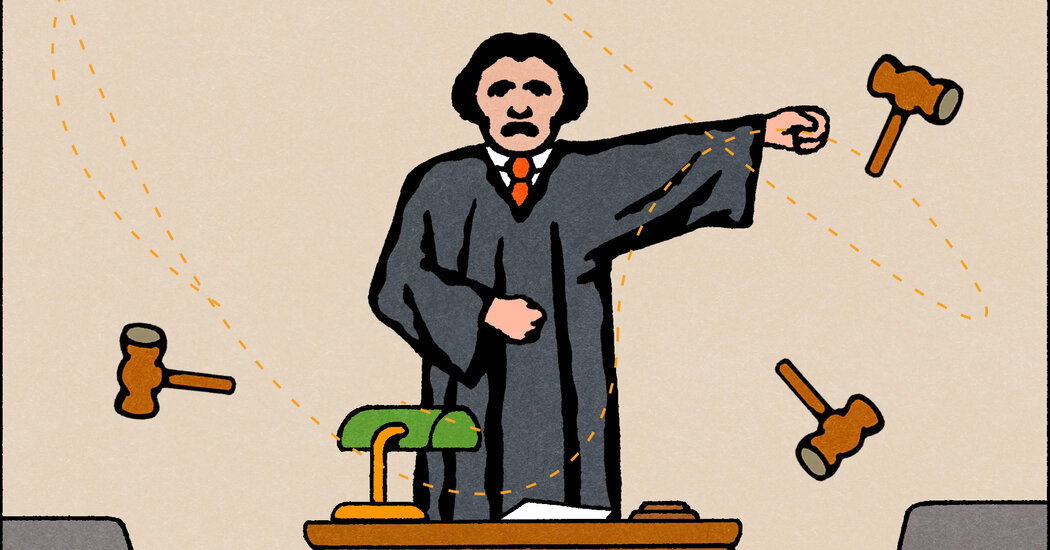For those of us who turn to the Supreme Court these days with a sense of foreboding, Wednesday morning’s argument on the legality of President Trump’s tariffs may offer temporary relief. Listening to it might even be fun.
I make this cheeky prediction without any intent to diminish the seriousness of the case. It concerns the president’s unilateral imposition of “tariffs of unlimited duration on nearly all goods from nearly every country in the world,” to quote the federal appeals court that found the tariffs unauthorized by the law Mr. Trump had invoked as his legal foundation. Aside from the many billions of dollars at stake, the case, Learning Resources Inc. v. Trump, has important implications for presidential power and for the relationship between the executive and legislative branches of the federal government.
In an argument session on such weighty matters that is very likely to last two hours or more, where does the fun come in? If it comes, it will be from watching the conservative justices struggle to reconcile their deference to the president — abundantly apparent in recent months from their multiple unsigned and unexplained orders giving him nearly everything he wanted — with the method they embrace in other contexts for interpreting statutes. Inconveniently for these justices, deference and law in this case are quite clearly pulling in opposite directions, and the conservatives may have to twist themselves into knots in the effort to reconcile them.
Cognitive dissonance is the phrase psychologists use to describe the uncomfortable mental state that results from simultaneously holding two contradictory attitudes or beliefs. Thanks to the livestreaming of the court’s argument audio, we can listen to “Cognitive Dissonance: The Play” in real time (10 a.m. Eastern).
For any justice looking for a way to uphold the tariffs, the challenge comes from many quarters. Justice Neil Gorsuch’s linguistic tic of beginning sentences with a verb in the imperative case has spread to many of his colleagues, and since he will be an especially important player in this drama, I’ll follow his model: Start with originalism. As a brief filed by nine constitutional scholars points out, the framers of the Constitution “unmistakably assigned to Congress” the authority to “lay and collect Taxes, Duties, Imposts and Excises.” In other words, tariffs, the subject of the second act of Congress, enacted even before it had created the Treasury Department.
For the next 150 years, in more than 260 laws, resolutions and proclamations, Congress kept its tariff authority to itself. Gradually, it began to delegate some authority to the executive branch, while maintaining clear boundaries for presidential discretion. When President Richard Nixon pushed the boundaries, Congress pushed back by setting ceilings and time limits.
The International Emergency Economic Powers Act, signed by President Jimmy Carter in 1977, represented a congressional effort to limit presidents’ reliance on invoking emergency powers when revising policies on international trade. It was consequently surprising that this was the law, known as IEEPA, from which President Trump claimed to derive his authority to set tariffs of his own devising.
Moving to the next challenge confronting the conservative justices: statutory interpretation. The problem, as the Court of Appeals for the Federal Circuit pointed out, is that “notably, IEEPA does not use the words ‘tariffs’ or ‘duties,’ nor any similar terms, like ‘customs,’ ‘taxes’ or ‘imposts.’” The appeals court noted further: “The absence of any such tariff language in IEEPA contrasts with statutes where Congress has affirmatively granted such power and included clear limits on that power.”
The Supreme Court’s current majority famously comprises “textualists” who believe that a statute’s words, not its purpose or effect, are the only legitimate guide to its meaning. In her recent book, “Listening to the Law,” Justice Amy Coney Barrett writes that “the basic rules of statutory interpretation are simple: ‘(1) Read the statute; (2) read the statute; (3) read the statute!’” Elaborating, she explains that “textualism works to ensure that the debate is about what Congress actually did and not about judicial speculation about what it wanted to do.”
Justice Gorsuch’s majority opinion in Bostock v. Clayton County in 2020 is an example of a self-described textualist meeting that test. The court held that gay and trans individuals are protected against employment discrimination by Title VII of the Civil Rights Act of 1964, which prohibits job-related discrimination on the basis of sex. Justice Gorsuch wrote that unfavorable treatment of gay or trans people because of their sexual identity is clearly discrimination on the basis of sex.
He rejected the argument that Congress in 1964 could not have foreseen or intended such a result. “Only the written word is the law, and all persons are entitled to its benefit,” he wrote. Among the conservative justices, only Chief Justice John Roberts joined Justice Gorsuch’s opinion. Justices Clarence Thomas, Samuel Alito and Brett Kavanaugh, in perhaps a display of early-onset cognitive dissonance, dissented.
Justice Barrett was not yet on the court when Bostock was decided; her arrival later that year brought the conservative majority to six. Who among them, if any, will be willing to jump off the textualist cliff by writing into IEEPA the word it is currently missing?
Even such a textual sleight of hand wouldn’t save the president’s tariffs from the so-called major questions doctrine. This is a recent invention that the conservative justices deployed to block several of President Joe Biden’s initiatives, including his student loan forgiveness plan, and impede his efforts to address climate change. Under this doctrine, courts are not to accept an executive branch policy departure with “economic and political significance” as simply an interpretation of existing authority. Rather, a “major question” of this sort requires “clear congressional authorization.”
In the tariff case, the Trump administration argued to the appeals court that the doctrine doesn’t apply to the president. But the appeals court said it couldn’t see “why it makes any difference whether the challenged action is the result of presidential or agency action.” Noting that no president had ever invoked IEEPA as authority to impose tariffs, or even to adjust tariff rates, the appeals court concluded that the Trump tariffs were a major departure from past practice, lacking the necessary congressional approval that the major questions doctrine requires.
Even if the justices who invented that doctrine are somehow able to write their way around it, they may find another of their favored doctrines standing in the way of tariff rescue. Ninety years ago, the court invoked something called the nondelegation doctrine to invalidate parts of President Franklin D. Roosevelt’s New Deal. The doctrine held that Congress could not delegate unbounded authority to an executive branch official — authority lacking an “intelligible principle” for the official to follow — without offloading its legislative role and thus violating the constitutional separation of powers.
While the constitutional crisis that resulted in Roosevelt’s victory over the Supreme Court pushed the nondelegation doctrine under the radar, the idea never disappeared. Led by Justice Gorsuch, the court came close to reviving it in a 2019 case, Gundy v. United States, but fell one vote short. Justice Kavanaugh, newly confirmed, did not participate in that case. He has expressed support for the doctrine, albeit less categorically than Justice Gorsuch.
The case to be argued on Wednesday consolidates cases brought against the tariffs by three groups of plaintiffs, and in their separate briefs, all three groups argue that if IEEPA gives the president the unbounded power that he claims, the statute is an unconstitutional delegation of legislative power. “The court can avoid nondelegation problems by rejecting the government’s reading of IEEPA,” small businesses that make up one group of plaintiffs assert in their brief.
It’s such a simple solution — one that an originalist, textualist justice who embraces the major questions and nondelegation doctrines might be relieved, even eager to grasp. But not so fast! On the other side of the case sits a president whose brief informs the justices that his tariffs are not only “country-saving” but fully supported by law. What a dilemma. What a show. Could be wild.
Linda Greenhouse, the recipient of a 1998 Pulitzer Prize, reported on the Supreme Court for The Times from 1978 to 2008.
The Times is committed to publishing a diversity of letters to the editor. We’d like to hear what you think about this or any of our articles. Here are some tips. And here’s our email: [email protected].
Follow the New York Times Opinion section on Facebook, Instagram, TikTok, Bluesky, WhatsApp and Threads.
The post Tune In to the Supreme Court on Wednesday. The Justices Will Be Squirming. appeared first on New York Times.




